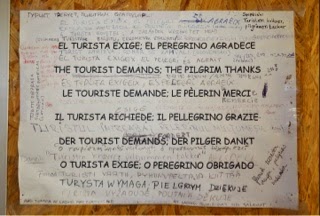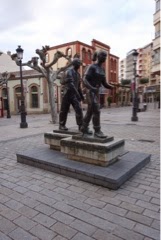Pilgrims have been camping, sleeping in hay lofts, churches, monasteries, convents, and wherever they could lay their heads since this walk began. Since it became an "official" cultural route of the European Union, every town and building along the Camino is of historical and cultural significance. We have heard varying stories about how helpful this has been (or not) for the residents of these villages and cities. The upshot means more people are walking and more of them expect certain services. One of the biggest services is the many places for resting after a long day on your feet.
Pilgrim Dude logo of one albergue
As a pilgrim, you register when you begin walking, and get a credential that you must present to be eligible to stay in many places. There are a variety of different options. The most common is the albergue (al-BEAR-gay). This is like a hostel, for pilgrims only. Most usually have a bunk room (or several bunk rooms) with shared bath. There is also often a place to hand-wash clothes and hang them out to dry. Some have a washing machine you can use for 2-3€, and a few will wash your clothes for you, for a fee. Many have a kitchen facility for those who wish to prepare their own meals. Some also have common areas - inside and/or out - for relaxing. There are public municipal albergues, parochial ones run by monks and nuns, and private ones.
Our first albergue in St. Jean Pied de Port
They vary A LOT! Some are very basic with no bedding (in some you get a spot on the floor for your mat). Some have a pillow and bottom sheet. Some have disposable bottom sheets. Some host 100+ people in one long room of bunks, others use dividing walls or have rooms with 4-10 bunks in a room. Some have twin beds (no top bunk - what a luxury!), and a few have rooms with only 3-4 people in each. A bed in an albergue can be on a donation basis at the parochial ones or ones run by associations of friends of the Camino, or it can be anywhere from 5-15€.
No boots in the bunk room - too stinky!
There are also other accommodation options, if you want a bit more "luxury". Some private albergues have single, double or triple private rooms as well as the bunk room. There are Casa Rurales and Pensiones, which are like bed and breakfasts. They often have rooms for 2, 3, or 4. and can range from 35-50+€ with a private bath (less if you share a common bath). Often these rooms come with a full set of sheets, a bath towel, and sometimes soap or shampoo.
Pilgrim St. James statue outside albergue in Rabinal Then there are hotels along the way. Some offer a pilgrim rate if you can show your credential. There are some folks we've met - particularly toward the end of the walk- who have made hotel reservations for their whole Camino experience. There is a LOT of debate among pilgrims as to whether this makes them tourists rather than 'true pilgrims', and how this commercialization and the use of sites like booking.com are changing the walk.
We have stayed in a wide variety of places, but mostly albergues - some municipal, some private, one run by the British Friends of the Camino. We have found that we like the smaller ones in smaller towns better than the huge ones in the city. We still haven't tried a parochial one. We have splurged a couple of times though on a private double room so that we can sleep! The noises in a room shared with lots of people - even with earplugs - can often make rest a challenge. Also, it can be challenging keeping all your items organized when you are cramped in with so many others. But we've gotten pretty good at settling in and packing up again in the morning.
Cows being herded through town for milking time, with pilgrim laundry drying in the background...
We usually know we've found a place we will really like by the way we are greeted. Some people are particularly good at meeting you where you are. Typically by the time you have walked all day and are looking for a room all you want is a place to put down your backpack and a shower. While the 'house rules' tend to be similar in most albergues, there are variations. You have to be told where to leave your boots, bathe, do laundry, cook or eat. You also have to present your pilgrim credential and sometimes your passport and (of course) pay.
Bunk room in one albergue
Some places offer a cup of tea when you arrive, some bark at you to take off your boots. Some offer a chair and give you a minute to collect the items needed from your pack, others start rattling off pertinent information before you can begin to take it all in (often in a variety of languages). Most of the people we have encountered who run albergues work hard to welcome pilgrims, and have long hard days. Some of the smaller places prepare meals for us as well as cleaning the bunk and bathrooms and doing untold amounts of laundry. Then it all starts anew for them the next day with new pilgrims.
There have been some who go above and beyond in the spirit of Christian hospitality. Here's a glimpse of those folks...
The man who runs the small municipal in his village. Pedro brought everyone's laundry in from the lines when it began to rain, and - realizing that some of the students had hoped to shop for food in the (non-existent) market - put yogurt and spoons out for breakfast so they wouldn't be walking hungry.
The kind volunteers at the British friends of the Camino albergue who serve tea to their guests each afternoon in their mountain village albergue, as well as providing a cozy fire in a little library.
A bench at the British albergue
The man who helps cook at the albergue in the Pyrenees. Jean Jacques also checks the pass for snow and ice, and personally shoveled/carved out steps through some challenging patches so that we (and all the other pilgrims) could safely walk over. He's the one who described the 80mph mountain winds as "muy tranquila"!
If you look closely you can see the trail he clears.
The golden retriever, Conan, at one albergue who wagged his tail as folks came in while his 'grandmother' Paula offered tea or coffee to pilgrims coming in from the rain.
The eager man of proud Basque heritage who worked hard to create an environment where pilgrims could know one another better and share food, stories & laughter.
The friendly fellow with the cute middle school son who helped run the reception area. They were both happy to answer LOTS of questions about food as we entered a new region of Spain.
The people who choose to welcome the day (aka wake up the pilgrims) with beautiful music! So nice when you need to be out by 8 and feel cared for rather than rushed.
One of the places that starts the day with music.
The kind man in a town with a population of 12 who hosted pilgrims as graciously as he did the sweet elderly neighbor who was joining him for dinner by the fire. Jaime's neighbor's brother died last year, so the neighbor comes over for dinner and company each day and watches the parade of pilgrims who dine at the table he can see from his spot near the fireplace.
The fun bartender/albergue owner who served an amazing and abundant communal meal for dinner, finished off with the traditional Galician Queimada!
Kirsten was asked to read the traditional encantation in English.






































